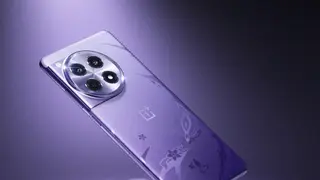Ketaki Bhojnagarwala
When the Samsung Wave was launched last year, many were surprised to learn that the company had chosen to market this high-end handset with its proprietary operating system, ‘bada'. A few weeks ago, Samsung added three new handsets to its Wave series, the 525, 533 and 723. We got the Wave 533 on our test bench, for our first look at the bada operating system.
First Impressions
The Wave 533 lacks the sleek look of most smartphones in the market today. It features a 3.2-inch WQVGA touch screen with a 240x400 resolution, which is a bit of a disappointment, because the original Wave shipped with a Super AMOLED screen. We expected to see at least a WVGA screen. The phone feels a bit clunky, with could be attributed to its slide-out QWERTY keypad. The exterior is shiny black plastic, and feels quite sturdy. The back panel has a dotted texture, presumably to offer more grip when typing on the pull-out keyboard.
The front has three buttons – for Call, End and a larger menu button in the centre. Unlike Android phones, the Menu button here only pulls up the phone's Menu, and doesn't display options specific to applications. We would have liked these buttons to be backlit. To make any changes, you'll have to manually go to your Settings and configure from there. The phone also lacks a Search and Home button.
On the exterior, other features are a mini USB slot and a 3.5mm headphone jack. There is also a power button on the side, as well as a dedicated camera button. The back panel features a 3.2-meg camera, but no LED flash.
The pull out QWERTY keypad has large, well spaced out keys. The keypad has dedicated arrow keys, as well as Alt, Caps and Symbol keys. The Alt key can be used to access the secondary function on a specific key, by short pressing and immediately pressing the key you want to use after.
Using it can take some getting used to, especially if you've been a BlackBerry user. However, we had no complaints when it came to using the keypad – we were able to type out text quickly, and we especially liked the big spacebar.
User Interface
Android has pretty much become the standard OS on most smartphones, so when we tried our hands at bada, we couldn't help but compare features.
The screen can be unlocked with a simple sweep feature to either side of the screen, which is actually easier to use than the Android sweep that we've seen on most smartphones. By default, the phone displays three home screens, but you can add up to 10 screens by tapping the small widgets toolbar on top and turning the phone to landscape mode. Similarly, you can add up to 10 screens to the Menu by using the Edit option. There is a constant touch panel at the bottom of the screen that by default displays Keypad, Contacts and Messages, and you can even choose to edit this and replace them with your most used apps. We would have liked the option to group apps into folders. While we appreciate the fact that we can customise the number of home and Menu screens, finding the option to do so was tedious and not intuitive – we had to read the user manual to even discover the feature was there.
The Widgets button also lets you add widgets to the home screen, and lets you rearrange them.
One feature the bada OS has in common with Android is the notification panel on the top, which displays recent alerts, as well as gives you one touch access to activate Bluetooth, Wi-Fi and Silent mode.
Media
We faced some complications when it came to media usage of the phone. The Wave 533 only supports mp4 and 3gp file formats. However, we had serious issues when it came to file compatibility.
The phone refused to play videos in any format – we tried mp4, and even loaded a couple of divX and avi files – but nothing played. We downloaded vPlayer, a third party video app from Samsung Apps, but videos didn't play on that either. Although the Samsung App store has a few thousand apps, it's way behind the Android Market and Apple App store in terms of the numbers and quality of apps.
The phone has an in-built music player, so you can listen to all your favourite tracks. Volume levels weren't too great though.
The camera is a decent 3.2-megger. It supports a variety of shooting modes, including Smile shot, Continuous, Panorama and Mosaic. There are a couple of scene modes to choose from as well. It picks up ambient light reasonably well – and is pretty decent for a phone camera. We liked having a physical camera button, but missed having a flash.
The handset comes with Facebook, Twitter and Orkut apps preloaded. The phone provides for contact integration, which is pretty standard on all phones. There is also an IM app preloaded, which gives you access to Palringo, as well as Yahoo and MSN Messenger. There's no dedicated Google Talk or Gmail app though – something you'll miss if you're used to Android.
Performance
The phone's battery life was really good – it lasted us two days with a few hours of talktime, web browsing and social networking sites logged on.
Call quality was clear too – Samsung always scores on this front.
The capacitive touch screen was one of the best in the mid-range smartphone segment we've come across so far, and we were even able to type without error using the touch QWERTY keypad in portrait mode.
The phone was able to run multiple applications smoothly, without slowing down performance. Long-pressing the menu key will bring up a list of running apps, and give you the option to switch between apps or end them.
Our Verdict
Overall, the phone just about classifies as an entry level smartphone – but just barely. In terms of looks and performance, it's like any other touch screen phone in the market. bada is a good first attempt by Samsung as an OS, but its nowhere near Android or Apple iOS. Until bada gets a few more updates and removes some of its glitches, it's better to stick to Samsung's lower end Androids like the Galaxy 3 or Galaxy 5.
Love – Good battery life
Hate – Not so user-friendly OS, clunky looks
Rs 9,900







Comments
Comments have to be in English, and in full sentences. They cannot be abusive or personal. Please abide by our community guidelines for posting your comments.
We have migrated to a new commenting platform. If you are already a registered user of TheHindu Businessline and logged in, you may continue to engage with our articles. If you do not have an account please register and login to post comments. Users can access their older comments by logging into their accounts on Vuukle.